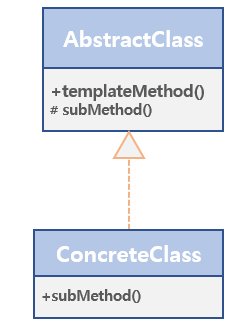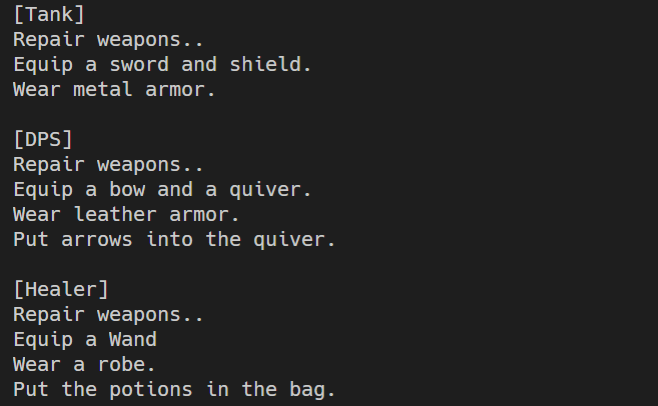Template Method Pattern
17 Jul 2020
Contents
- What is Template Method Pattern?
- Why use Template Method Pattern?
- Example
- UML diagram
- Implementation
What is Template Method Pattern?
Template Method Pattern defines the skeleton of an algorithm in a method, deferring some steps to subclasses. Template Method lets subclasses redefine certain steps of an algorithm without changing the algorithms structure. – GoF Design Patterns
AbstractClass: A class that defines a template method. AbstractClass defines a common algorithm of subclasses and the functions that will be implemented in a subclass as primitive methods or hook methods.ConcreteClass: A class that implement inherited primitive or hook methods. ConcreteClass overrides the primitive or hook methods to suit the subclass.
Why use Template Method Pattern?
It is useful when minimizing code duplication of a method that is the same overall but partly different.
- Template Method Pattern defines the same functionality in the superclass, allowing only the parts that need to be expanded or changed to be implemented in the subclass.
- Template Method Pattern implements common algorithms in the superclass, and implements different algorithms in subclasses. Therefore, it is useful for reusing the overall algorithm code.
Problems
- If there are too many abstract method that Concrete Class must implement, management becomes
complicated. - When there are many subclasses managed by a superclass , if the superclass is modified,
all subclassesmust be modifiedindividually.
Example
When we play any rpg game, there are many Classes such as DPS, Tank, Healer, etc.
The role of DPS is to increase damage and kill monsters quickly. They also usually use long-range weapons because they have to be at a safe distance from monsters. The role of a tank is getting an attack from a monster to protect party members. Therefore, defense will be important. Finally, the role of the healer will be to restore the injury of the party members.
- Classes (AbstractClass)
- Tank (ConcreteClass)
- DPS (ConcreteClass)
- Healer (ConcreteClass)
public abstract class Classes {
void readyToBattle() {
repairWeapons();
prepareWeapon();
prepareArmor();
if (isUsingPrepareOther()) {
prepareOther();
}
}
final void repairWeapons(){
System.out.println("Repair weapons..");
}
abstract void prepareWeapon();
abstract void prepareArmor();
// If you want to prepare something else, you have to change it to 'true'.
boolean isUsingPrepareOther() {
return false;
}
// Override 'isUsingPrepareOther' value to use.
void prepareOther() {
};
}
Creates an abstract class called Classes that defines all classes.
All Classes need to repair their weapons before a fight, abstract keyword is not used in repairWeapons method.
Create a hook method for a class that requires different preparation. isUsingPrepareOther can be used for classes that require different preparation.
When the readyToBattle method is executed, the remaining methods are executed in turn.
public class Tank extends Classes {
@Override
void prepareWeapon() {
System.out.println("Equip a sword and shield.");
}
@Override
void prepareArmor() {
System.out.println("Wear metal armor.");
}
}
The tank class uses swords and shields, and wears metal armor. So, let’s just prepare the weapons and the armors.
public class DPS extends Classes {
@Override
void prepareWeapon() {
System.out.println("Equip a bow and a quiver.");
}
@Override
void prepareArmor() {
System.out.println("Wear leather armor.");
}
@Override
boolean isUsingPrepareOther() {
return true;
}
@Override
void prepareOther() {
System.out.println("Put arrows into the quiver.");
}
}
Let’s suppose there is a archer in dps class.
The DPS class uses a bow and quiver or a gun, and wears leather armor to move quickly. Also, use hook method to prepare arrows.
public class Healer extends Role {
@Override
void prepareWeapon() {
System.out.println("Equip a Wand");
}
@Override
void prepareArmor() {
System.out.println("Wear a robe.");
}
@Override
boolean isUsingPrepareOther() {
return true;
}
@Override
void prepareOther() {
System.out.println("Put the potions in the bag.");
}
}
Healer uses a a wand, and wears a robe. Healers also need to pack enough potions.
Lastly, let’s test the pattern.
public class TemplateMain {
public static void main(String[] args) {
System.out.println("[Tank]");
Tank class01 = new Tank();
class01.readyToBattle();
System.out.println();
System.out.println("[DPS]");
DPS class02 = new DPS();
class02.readyToBattle();
System.out.println();
System.out.println("[Healer]");
Healer class03 = new Healer();
class03.readyToBattle();
}
}



